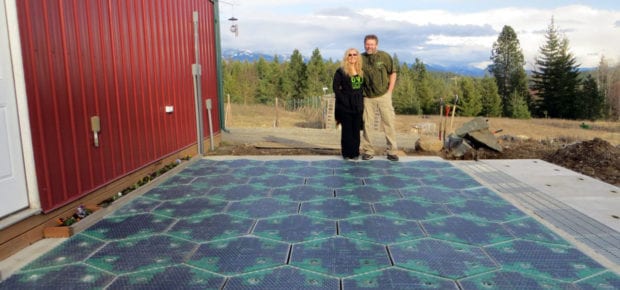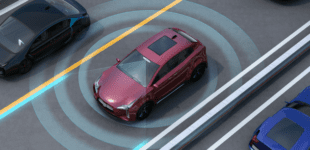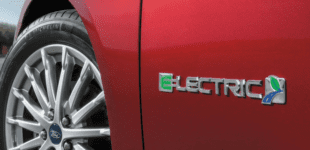September 10, 2015
Consumers have long embraced solar-powered technology as a somewhat “futuristic” way to help power and heat their homes. It’s hard to drive through today’s neighborhoods without spotting at least one home with a roof decked out in solar panels. But now, solar power has found its place on the road.
Solar-Powered Roads
There are plenty of startup success stories that have emerged from tiny garages, and yet most people fixate on the creation of the Macintosh computer. But have you heard the story of the exciting innovations that were sparked – not literally – from someone’s oil-spilled garage?
Julie and Scott Brusaw co-founded Solar Roadways after recognizing a need for an electric car-charging road that collects energy from the sun, helping power the entire U.S. grid.
https://vimeo.com/111570431
It’s easy to hear the phrase “illuminated roadway” and think back to a movie like Tron, but thanks to modern innovation, Solar Roadways might become a reality. Solar Roadways are made up of photovoltaic cells and tempered glass that can withstand the weight of a 125 ton vehicle and offer enough traction to stop a car traveling at 128 kph on a wet surface. These roadways cover the solar cells and circuit boards with LED lights that can be programmed to light roads from the surface to help indicate lane lines, speed limits, even upcoming slow traffic. The hexagonal solar panels are connected to one another so if one stops working, the others will be able to communicate the problem to an engineer. Solar Roadways offer a solution to weather-related driving hazards, as they generate enough heat to melt ice and snow in colder climates, and could be used to collect and recycle runoff from the roads to ensure filtration.
While Solar Roadways are in testing, solar roads are already being implemented in Oregon. The Oregon Solar Highway project doesn’t cover a huge stretch of highway, yet the power generated from it already provides more than a third of the energy required to light the highway. If this technology continues to grow and all of the roads in the United States were replaced by effective solar-powered roads, Scott Brusaw believes we could “theoretically cut greenhouse gas emission by up to 75%” and provide a cleaner, greener future around the world.
Solar Bike Paths
If transitioning US roadways to solar-powered roads cuts 75% of greenhouse gas emissions, imagine what changing all of the roads and paths around the world could do. A Netherlands-based company called SolaRoad currently uses safety glass-covered solar cells placed in concrete to collect energy from a bike path connecting two Amsterdam suburbs, and their success might be a strong global example. Out of the 150,000 cyclists who have already tested the new path, there have been few complaints aside from a few maintenance issues with peeling laminate.
The path has generated 3,000 kWh of electricity in its first six months of use and hopes to improve upon that number in its next two and a half years of monitored use. The US has taken note, with California agreeing to cooperate with SolaRoad for future projects, making this an international effort.
Whether or not solar power is the perfect clean energy solution remains to be seen, but considering the large area taken up by roads and paths, and the ease of including solar cells in heavily-populated areas, solar powered roads and paths could represent at least one element of the perfect solution in our search for cleaner energy.





 The Impact of Technology in 2025
The Impact of Technology in 2025 Quantum and AI: Safeguards or Threats to Cybersecurity?
Quantum and AI: Safeguards or Threats to Cybersecurity? Why AI Can't Live Without Us
Why AI Can't Live Without Us Bits, Bytes, Buildings and Bridges: Digital-Driven Infrastructure
Bits, Bytes, Buildings and Bridges: Digital-Driven Infrastructure Impact of Technology in 2024
Impact of Technology in 2024 Emerging AI Cybersecurity Challenges and Solutions
Emerging AI Cybersecurity Challenges and Solutions The Skies are Unlimited
The Skies are Unlimited Smart Cities 2030: How Tech is Reshaping Urbanscapes
Smart Cities 2030: How Tech is Reshaping Urbanscapes Impact of Technology 2023
Impact of Technology 2023 Cybersecurity for Life-Changing Innovations
Cybersecurity for Life-Changing Innovations Smarter Wearables Healthier Life
Smarter Wearables Healthier Life Infrastructure In Motion
Infrastructure In Motion The Impact of Tech in 2022 and Beyond
The Impact of Tech in 2022 and Beyond Cybersecurity, Technology and Protecting Our World
Cybersecurity, Technology and Protecting Our World How Technology Helps us Understand Our Health and Wellness
How Technology Helps us Understand Our Health and Wellness The Resilience of Humanity
The Resilience of Humanity Harnessing and Sustaining our Natural Resources
Harnessing and Sustaining our Natural Resources Creating Healthy Spaces Through Technology
Creating Healthy Spaces Through Technology Exceptional Infrastructure Challenges, Technology and Humanity
Exceptional Infrastructure Challenges, Technology and Humanity The Global Impact of IEEE's 802 Standards
The Global Impact of IEEE's 802 Standards Scenes of our Cyber Lives: The Security Threats and Technology Solutions Protecting Us
Scenes of our Cyber Lives: The Security Threats and Technology Solutions Protecting Us How Millennial Parents are Embracing Health and Wellness Technologies for Their Generation Alpha Kids
How Millennial Parents are Embracing Health and Wellness Technologies for Their Generation Alpha Kids Space Exploration, Technology and Our Lives
Space Exploration, Technology and Our Lives Global Innovation and the Environment
Global Innovation and the Environment How Technology, Privacy and Security are Changing Each Other (And Us)
How Technology, Privacy and Security are Changing Each Other (And Us) Find us in booth 31506, LVCC South Hall 3 and experience the Technology Moon Walk
Find us in booth 31506, LVCC South Hall 3 and experience the Technology Moon Walk Virtual and Mixed Reality
Virtual and Mixed Reality How Robots are Improving our Health
How Robots are Improving our Health IEEE Experts and the Robots They are Teaching
IEEE Experts and the Robots They are Teaching See how millennial parents around the world see AI impacting the lives of their tech-infused offspring
See how millennial parents around the world see AI impacting the lives of their tech-infused offspring Take the journey from farm to table and learn how IoT will help us reach the rising demand for food production
Take the journey from farm to table and learn how IoT will help us reach the rising demand for food production Watch technical experts discuss the latest cyber threats
Watch technical experts discuss the latest cyber threats Explore how researchers, teachers, explorers, healthcare and medical professionals use immersive technologies
Explore how researchers, teachers, explorers, healthcare and medical professionals use immersive technologies Follow the timeline to see how Generation AI will be impacted by technology
Follow the timeline to see how Generation AI will be impacted by technology Learn how your IoT data can be used by experiencing a day in a connected life
Learn how your IoT data can be used by experiencing a day in a connected life Listen to technical experts discuss the biggest security threats today
Listen to technical experts discuss the biggest security threats today See how tech has influenced and evolved with the Games
See how tech has influenced and evolved with the Games Enter our virtual home to explore the IoT (Internet of Things) technologies
Enter our virtual home to explore the IoT (Internet of Things) technologies Explore an interactive map showcasing exciting innovations in robotics
Explore an interactive map showcasing exciting innovations in robotics Interactively explore A.I. in recent Hollywood movies
Interactively explore A.I. in recent Hollywood movies Get immersed in technologies that will improve patients' lives
Get immersed in technologies that will improve patients' lives